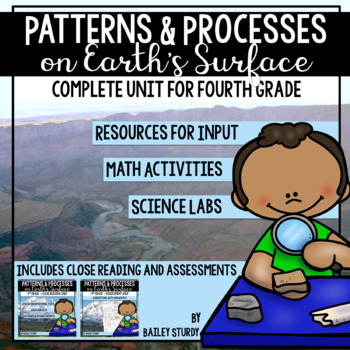4th Grade NGSS Earth Science Unit
- Zip
Also included in
- Save 25% by buying the bundle! This bundle includes all 4 units for fourth grade: Energy, Earth Science, Waves, and Plant and Animal Structures.In this bundle you will find:Resources for InputInquiry ChartObservation ChartsBig Book (PPT or printable)Pictorial and Comparative Input Chart templates (2Price $43.50Original Price $58.50Save $15.00
Description
This NGSS-aligned unit includes science, literacy, and math activities to teach systems on Earth's surface. The topics include plate tectonics, weathering, erosion, natural hazards, and changes to the Earth that are visible in formations and the fossil record.
Included in this packet:
Resources for Input:
- Unit essential question
- Inquiry chart printable
- Observation chart photos
- Printable Cognitive Content Dictionary and teacher samples
- I Just Thought You'd Like to Know About Patterns in Earth's Surface Big Book
- PPT version of the big book
- Super Scientist Awards
- 6 pictorial input charts to project and trace
- Earth's Layers
- Plate Tectonics
- Topography
- Stratigraphy
- Weathering
- Erosion (can be combined with weathering chart into comparative input)
- Geology Bugaloo chant
- Weathering and Erosion chant
- Plate Tectonics Chant
- 4 different printable sentence pattern charts and teacher sample
- Weathering, Erosion, and Deposition Expert Groups (set of 6) with mind map graphic organizer and process grid: Thermal Stress, Freeze-Thaw, Amount of Vegetation, Wind Speed, Slope Gradient, Rate of Deposition
- Natural Hazards Expert Groups (set of 6) with mind map graphic organizer and process grid: Earthquakes, Volcanic Eruptions, Landslides, Tsunamis, Floods, Mudslides
- 3 writing prompts (narrative, informational, and opinion) and writing paper
Close Reading:
- 3 close reading passages with sample CCSS anchor charts, 3 printable question sets aligned to CCSS, and 2 journal prompts
- Titles:
The History of the Grand Canyon
Plate Tectonics
Mudslides in California/Mud Creek and Big Sur (paired texts)
Each passage is available in a beginning, middle, and end of fourth grade reading level. This component is also available digitally as Google Slides presentations. There are 9 links: a presentation for each leveled text that also includes the question sets and journal prompts.
Please NOTE: the close reading passages in this unit are the same ones in the Fourth Grade Close Reading Bundle and Earth Science Close Reading.
Math Integration Activities:
- 5 math activities (3 center-type activities with recording sheets and 2 sets of printable worksheets)
Titles:
Unit Conversion Rocks!
Stratigraphic Circles
Word Problem Weathering
Multiplication Formations
Divergent Decimals
Science Labs:
- 7 science labs with teacher directions and printable recording sheets
Titles:
Earth's Layers Model
Oreo Plate Tectonics
Modeling Earth's Shape
Stratigraphy in a Cup
Weathering and Erosion
Landform Lab
Tsunami Design Challenge
Art Integration:
- Printables of 6 works of art
- Guiding questions relating science concepts to the artworks
- 1 art lesson
Assessment:
- 1 assessment (18 questions with answer key)
Note: The assessment is available separately here.
Answer keys are included for the close reading standards-based questions, certain math activities and science lab reflections.
Want more NGSS units? Click here.






